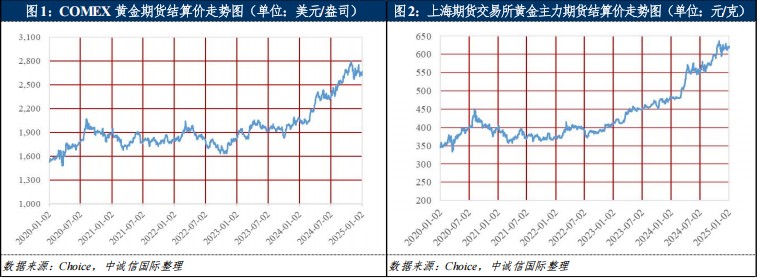
China Chengxin International: The gold price is expected to fluctuate upward in 2025, and the profitability of gold companies may further improve

中誠信國際預計 2025 年黃金價格將震盪上行,受美聯儲降息預期、地緣政治緊張及避險需求擴大等因素影響,黃金企業盈利有望進一步改善。儘管黃金消費需求承壓,但企業經營能力提升,資本結構優化,槓桿水平穩定,行業信用基本面將維持穩定。未來 12~18 個月,整體信用質量預計不會發生重大變化。
智通財經 APP 獲悉,中誠信國際發佈《中國黃金行業展望 (2025 年 1 月)》,其中指出,2024 年以來,美聯儲降息預期持續、地緣政治加劇、避險需求擴大等因素推動黃金價格迭創新高,年內金價漲幅超 20%。黃金供應整體較為穩定,價格上漲致使黃金消費需求承壓。隨着黃金價格的快速上漲,黃金企業經營能力和經營獲現能力進一步提升,黃金企業對外部融資依賴減弱,資本結構較優且槓桿水平相對穩定。由於地緣政治、美聯儲貨幣政策和財政政治的不確定性尚存,而黃金作為避險資產的需求提升對未來黃金價格表現起到提振作用,2025 年黃金價格預計將震盪上行,此背景下的上游礦山利潤增厚或將使得黃金企業盈利進一步好轉,行業信用基本面將維持穩定。
中國黃金行業展望
2024 年,美聯儲降息預期持續、地緣政治局勢緊張加劇、避險需求擴大等因素推動黃金價格迭創新高,年內金價漲幅超 20%。隨着黃金板塊量價齊升,企業盈利能力有所增強,雖然企業債務規模有所上升,但得益於黃金特殊性、債務結構的優化及資金面寬鬆,整體信用水平保持穩定。中誠信國際認為未來 12~18 個月行業總體信用質量不會發生重大變化。
要點
2024 年以來,美聯儲降息預期持續、地緣政治加劇、避險需求擴大等因素推動黃金價格迭創新高,年內金價漲幅超 20%。地緣政治、美聯儲貨幣政策和財政政策不確定性尚存,黃金作為避險資產的投資需求提升對黃金價格表現起到提振作用。
全球黃金供應較為穩定,2023 年以來礦產金產量小幅提升,金價整體上行刺激回收金投放量顯著升高,帶動黃金供應量同比有所增加,不過黃金供給側整體波動較小,對金價影響不大。
2024 年以來,黃金價格飆升持續抑制金飾消費需求和黃金 ETFs 投資,黃金投資及央行購金需求有所波動,帶動黃金需求小幅下降,但受益於場外交易補充,前三季度黃金總需求量同比仍有增長,若未來黃金需求端進一步好轉,黃金或將迎來相對供需平衡。
2023 年以來,黃金板塊量價齊升令黃金企業利潤及現金流持續向好,擴產項目推進及資源收併購推升資金需求,總債務規模擴大,但債務結構優化及資金面寬鬆使得短期流動性壓力不大,且受益於黃金特殊性,整體信用水平保持穩定。
一、分析思路
黃金行業的信用基本面分析,主要是通過分析黃金價格走勢以及影響黃金供應和需求的相關因素,並對價格走勢進行判斷,進而分析價格走勢對行業財務狀況的影響、企業盈利水平和槓桿水平等信用基本面的變化情況。本文指出黃金供應和需求對價格產生一定影響,但在經濟不確定性因素增加的大背景下,黃金避險和保值需求及實際利率對價格的影響更為顯著。受益於黃金價格及產銷量的提升,黃金企業盈利及經營獲現能力有所提升,黃金企業槓桿比率雖有所分化,但得益於黃金特殊性及債務結構的優化,整體信用水平保持穩定。
二、行業基本面
黃金價格與金融屬性
2024 年以來,美聯儲降息預期持續、地緣政治加劇、避險需求擴大等因素推動黃金價格迭創新高,年內金價漲幅超 20%。地緣政治、美聯儲貨幣政策和財政政策不確定性尚存,黃金作為避險資產的投資需求提升對黃金價格表現起到提振作用。
受美聯儲降息預期持續疊加地緣政治局勢緊張加劇等因素影響,黃金對抗貨幣貶值和政治經濟風險的保值及避險需求較為旺盛,2024 年以來黃金價格屢創新高,年末 COMEX 黃金期貨結算價收於 2,641.00 美元/盎司,全年均價為 2,403.55 美元/盎司,同比增長 22.97%。具體來看,2024 年年初美國非農就業數據超預期回暖,美聯儲降息遇冷,但美國零售銷售總額疲軟且 2023 年四季度 GDP 低於預期,疊加紅海航線、巴以局勢緊張以及紐約社區銀行評級下調等引發市場避險情緒,同時央行購金趨勢持續對金價形成支撐,COMEX 金價從 2,000 美元/盎司附近攀升至超 2,400 美元/盎司。4 月下旬,美國經濟數據好於預期,美元走強令金價回吐部分漲幅;5 月美聯儲利率決議釋放鴿派信號,美國宏觀環境不確定性上升,疊加地緣政治加劇等因素影響,金價繼續震盪上行。
9 月美聯儲以 50 個基點開啓降息週期,幅度略超市場預期,美聯儲寬鬆貨幣政策仍將持續,且地緣政治影響仍未消退,金價強勢上漲,10 月 30 日 COMEX 黃金價格期貨結算價達到 2,800.80 美元/盎司,系全年最高點。11 月美聯儲再次降息 25 個基點,但特朗普勝選帶來美聯儲降息放緩及地緣局勢局部緩和預期,對黃金價格形成利空,金價大幅回調,後續俄烏局勢升温激發全球資產避險情緒,黃金價格再次回升。12 月美聯儲繼續降息 25 個基點,但美聯儲偏鷹表態使得 2025 年降息預期回落,黃金價格高位震盪。
國內方面,2024 年以來,國內金價緊跟國際金價走勢,上海期貨交易所 (SHFE) 黃金期貨結算價 1~2 月橫盤震盪,3 月以來大幅上漲,後於 4 月觸及上半年最高價 590.65 元/克開始回落,後在 560 元/克附近做區間震盪。9 月以來我國央行降息降準、降低存量房貸利率以及推動中長期資金入市等增加了市場流動性,提振市場信心的同時亦增加投資需求,亦推動國內金價上漲,年末 SHFE 黃金結算價達到 616.68 元/克,較年初大幅增長 28.30%,全年均價為 559.11 元/克,同比增長 24.11%。

黃金的價格屬性包含大宗商品屬性與金融屬性,其中需求因素對商品屬性形成一定影響,但其金融屬性影響更大,金融屬性下的黃金本質上可以被視為長久期的抗通脹付息債券,其對沖貨幣貶值和政治經濟風險的避險及保值需求較為旺盛,因此在金融屬性下驅動黃金價格的核心因素為實際利率。如用 10 年期美國國債收益率代表無風險利率,當無風險利率下降時,投資者持有黃金的機會成本降低,大幅買入黃金使得黃金價格上升,以前年度黃金價格的上升往往伴隨經濟政治風險事件和國債收益率走低 [1]。2024 年內美聯儲三次降息帶來了 9 月以來黃金價格衝高,且 2025 年降息預期仍可能帶來實際利率的下行。從與美元的關係來看,黃金價格與美元亦呈現一定的負相關性。負相關性一方面來自於美元是黃金的基礎定價工具,美元的弱勢則對應了定價對象價格的相對上升。另一方面,黃金是一般貨幣等價物,當美元處於弱勢被拋售的時候,其他貨幣的相應價值會出現上升。通脹也會從一定層面影響黃金價格,2024 年美國經濟面臨一定的通脹壓力,但仍高於目標水平,在高通脹環境下,黃金作為抗通脹資產的吸引力增加,投資者會增加對黃金的配置,推動金價上漲。
傳統黃金定價中金價通常與美債利率及美元反向變動,但地緣政治風險和美元信用危機等因素對金價形成擾動,2023 年 10 月中東危機等因素導致市場避險情緒上升,期間美債收益率與黃金價格均呈現同時上升的態勢;2024 年 9 月以來美國消費數據保持韌性,市場對經濟前景的預期改善推動了美債收益率上升,但地緣局勢緊張持續以及對通脹升温的隱憂亦推動 9~10 月黃金價格上漲。整體來看,2023~2024 年十年期國債收益率及美元指數總體寬幅震盪,在美元保持強勢的背景下,地緣政治風險、避險情緒及央行購金需求等推升金價持續走高。
展望 2025 年,美國經濟的通脹壓力並未完全消除,降息預期猶存,仍將一定程度上對黃金價格形成支撐,但從特朗普第二任期 “降低利率、對內減税、限制移民、增加關税” 等核心政策主張來看,美聯儲貨幣政策仍將面臨一定的不確定性。若美國通脹反彈促使美聯儲貨幣政策超預期收緊,強勢美元或為黃金價格帶來短期回調壓力,但增加關税或導致美國經濟增速放緩,提高財政赤字使得美國政府債務負擔高企局面短期難改,美元預計將持平或略微走弱令黃金吸引力進一步增強,對黃金長期價格提升起到積極作用。此外,中東、朝鮮半島、俄烏緊張局勢等均未有明顯緩和跡象,地緣政治危機亦可能推動黃金價格上漲。整體來看,2025 年地緣政治、美聯儲貨幣政策和財政政策不確定性尚存,或將促使黃金作為避險資產的投資需求提升,對黃金價格長期表現起到提振作用。

黃金供應
全球黃金供應較為穩定,2023 年以來礦產金產量小幅提升,金價整體上行刺激回收金投放量顯著升高,帶動黃金供應量同比有所增加,不過黃金供給側整體波動較小,對金價影響不大。
全球黃金供應主要來源於金礦產金和回收金再加工生產以及少量生產商淨套保,近年來供應結構較為穩定。2023 年及 2024 年前三季度全球黃金總供應量分別為 4,950.0 噸和 3,761.9 噸,同比分別增長 3.97% 和 2.74%。
礦產金方面,黃金屬不可再生資源,根據美國地質調查局 (USGS) 的數據,截至 2023 年末,全球黃金儲量約 59,000 噸。受資源儲量及開採技術等影響,整體增產空間仍不足。2023 年,金礦產金 3,643.9 噸,同比增長 0.30%,佔全球黃金總供應量的 73.61%,金礦產量同比保持穩定;2024 年前三季度,受益於黃金生產商緊抓有利市場機遇推動增產,金礦產金同比增長 2.96% 至 2,768.4 噸,佔全球黃金總供應量的 73.59%。回收金的投放主要受黃金價格走勢的影響,2023 年以來,黃金價格持續上漲接連突破歷史新高,黃金回收經濟性有所提升,2023 年及 2024 年 1~9 月回收金投放量分別為 1,238.7 噸和 1,009.6 噸,同比增速分別為 8.65% 和 9.11%。從供應彈性來看,2023 年以來,黃金價格上漲明顯,礦產金增長較為緩慢,回收金投放有所增長,但整體黃金供給增幅有限,供應彈性相對較低。

從區域分佈來看,各區域黃金生產趨勢性變化不同,非洲黃金礦產資源豐富且分佈較廣,近年來產量長期位於全球黃金產量首位,且隨着多座礦山開發進程的加快,非洲礦山產量增長較快,2023 年非洲礦產金產量首次突破 1,000 噸。我國為黃金生產第一大國,2023 年主力礦山生產已恢復至山東省內非煤礦山整改前水平 [2],礦產金產量微增至 378.2 噸,土耳其礦產金產量提升亦帶動亞洲礦產金產量實現回升。
國內方面,2023 年末中國金礦保有儲量為 3,203.77 噸,約佔全球總儲量的 5%。我國金礦的分佈不均,主要集中在山東、河南、江西、內蒙古、雲南、甘肅等省份。探礦增儲方面,山東省在新一輪找礦突破戰略行動中取得探礦增儲上的重大突破,山東萊州西嶺金礦成為國內已發現的最大單體金礦牀,屬世界級巨型單體金礦牀,經初步認定,西嶺金礦新增金金屬量近 200 噸,累計金金屬量達 580 噸。2024 年 11 月,湖南省地質院宣佈在平江縣萬古金礦田地下 2,000 米以上發現超過 40 條金礦脈,探礦核心區累計探獲黃金資源量達到 300.2 噸,金品位最高可達每噸 138 克,同時預測地下 3,000 米以上遠景黃金儲量超 1,000 噸,萬古金礦田有望成全球最大金礦之一,為國內黃金礦山增產帶來新的動能。

隨着國內老礦山易開採資源逐漸減少,而海域金礦、紗嶺金礦和西嶺金礦等新建大型礦山尚未形成新增生產能力,近年來國內企業紛紛突破國內資源約束,加大了對國外資源的併購和開發力度。具體來看,紫金礦業集團股份有限公司 2023 年內完成蘇里南 Rosebel 金礦項目收購 [3];2024 年 10 月,紫金礦業擬出資 10 億美元收購加納 Akyem 金礦 [4],後於 12 月完成收購秘魯 La Arena 金礦 [5],資源儲備進一步增厚。山東黃金礦業股份有限公司下屬子公司山金國際黃金股份有限公司於 2024 年 8 月完成 Osino Resources Corp.股權收購,將新增黃金資源量約 127.2 噸。招金礦業股份有限公司 2023 年以來完成對鐵拓礦業 100% 股權及科馬洪金礦的控股權收購,鐵拓礦業所屬阿布賈金礦黃金資源量合計約 119 噸。隨着 “走出去” 戰略持續推進,近年來中國重點黃金企業境外礦山實現礦產金產量持續提升,2023 年及 2024 年前三季度分別實現黃金產量 60.38 噸、51.90 噸,同比分別增長 18.28%、20.50%[6]。值得關注的是,國內企業加大國外資源整合力度,但收購的部分項目需要一定的建設期及爬產期,對業績影響或有一定滯後,且海外礦產資產較多的企業面臨因當地政治經濟形勢變動影響礦權控制力的風險及一定社區風險,匯率及政策風險亦為海外業務的發展帶來很大挑戰。
整體來看,全球黃金供應較為穩定,2023 年以來全球礦產金產量略有增加,金價大幅上漲刺激回收金投放量顯著升高,帶動黃金總供應量有所增加,不過黃金供應彈性相對較低,且黃金價格持續高於生產成本,供應端變化對金價影響不大。
黃金需求
2024 年以來,黃金價格飆升持續抑制金飾消費需求和黃金 ETFs 投資,黃金投資及央行購金需求有所波動,帶動黃金需求小幅下降,但受益於場外交易補充,前三季度黃金總需求量同比仍有增長,若未來黃金需求端進一步好轉,黃金或將迎來相對供需平衡。
黃金需求主要來源於金飾消費、科技製造、金條金幣投資及黃金 ETFs 投資產生的持倉量需求及各國央行儲備需求。2023 年全年黃金需求量 (不含場外交易,圖中數據均不含場外交易量) 為 4,490 噸,同比下降 4.57%,但若將場外交易 (460 噸) 計算在內,黃金總需求實現增長。2024 年前三季度,黃金需求量 (不含場外交易) 為 3,259 噸,同比下降 2.69%。

具體來看,2023 年,全球金飾消費需求基本保持穩定。分國家來看,黃金價格上漲令多數國家金飾消費需求有所下降,但中國經濟復甦以及結婚率回升提振中國金飾消費需求,中國以 671.9 噸金飾消費需求量超過印度重回金飾消費第一大國。2024 年前三季度,黃金價格飆升抑制金飾消費需求,全球金飾需求量同比下降超 10% 至 1,328.34 噸,金飾消費佔黃金需求比例有所下降。
科技用金在全球黃金需求結構中佔比不大,主要涵蓋電子用金、其他行業用金和牙科用金,其中電子用金佔科技用金的 80% 左右。上漲的金價對電子用金需求形成拖累,2023 年消費電子用金需求疲軟,科技用金同比下降 3.06% 至 305.2 噸,但 2023 年四季度以來人工智能熱引領半導體行業復甦,對科技用金需求形成一定支撐,2024 年 1~9 月隨着需求回暖,科技用金同比上漲 9.31% 至 243.7 噸。
實物黃金與黃金 ETFs 共同構成了黃金投資需求,實物黃金投資主要涵蓋金條與金幣投資,2023 年金條和金幣投資量為 1,189.6 噸,同比下降 2.66%。分地域來看,實物黃金投資需求呈 “東昇西降” 的態勢,受利率上升和生活成本危機影響,以德國為代表的歐洲國家黃金投資大幅下降,而中國股市以及房地產市場表現較為低迷使得黃金的風險對沖作用凸顯,土耳其在高通脹率以及本幣貶值的雙重壓力下亦大幅增加黃金投資,兩個地區投資的增加大幅抵消了歐洲國家投資的下降。2024 年前三季度,全球實物黃金投資需求分化趨勢持續,金條和金幣投資量為 859.34 噸,同比略降 1.74%。
黃金 ETFs 因其具有大部分交易性金融工具屬性,且與一般證券投資工具收益率呈一定負相關關係,在大類資產配置中扮演較為重要的角色。相比於實物金條市場,以中國為主的亞洲市場在全球黃金 ETFs 持倉規模中佔比較低 (約為 5%),全球黃金 ETFs 持倉由歐美市場主導。2023 年,受利率飆升和美元走強的衝擊,全球黃金 ETFs 投資需求為-244.2 噸,其中歐洲基金淨流出最高,全年黃金 ETFs 投資需求為-180 噸,帶動全球投資需求為負。亞洲 (以中國為主) 黃金 ETFs 持倉變化與實物黃金投資需求亦具備較強的正相關性,2023 年亞洲 ETFs 投資需求為 19 噸,其中,中國為 10 噸。2024 年初,黃金 ETFs 需求量持續為負,隨着多國開啓降息週期,中東地緣政治緊張局勢加劇等為黃金 ETFs 流入提供支撐,1~9 月全球黃金 ETFs 投資需求為-25.5 噸。
央行儲備方面,黃金在各國央行資產配置中佔有重要地位。2023 年,以中國為代表的發展中國家央行保持穩健的黃金增持節奏,部分發達國家亦選擇增持黃金,中國、波蘭和新加坡央行作為購金量前三名共同驅動了全球央行持續的購金趨勢,全年淨購金量達到 1,037 噸。2024 年 1~9 月,受高金價影響,各國央行增加黃金儲備的步伐有所放緩,淨買入黃金量為 693.5 噸,同比下降 16.79%。我國央行亦在 2024 年 5~10 月連續六個月暫停增持黃金,結束了此前連續 18 個月的增持黃金記錄,11 月黃金價格高位回調,央行再次增持黃金。

整體來看,2024 年以來,央行儲備仍然保持一定需求韌性,但黃金價格走高使得金飾消費需求下降和黃金 ETFs 投資下降,前三季度黃金需求量同比略有下降,場外交易活動的增加促進了全球黃金需求,其對全球黃金總需求的貢獻不可忽視,但具體數據不易公開透明增加了黃金需求前景的不確定性。未來若黃金需求端進一步好轉,黃金或將迎來相對供需平衡。儘管存在供需失衡局面,但黃金定價由佔市場存量規模較小的流通部分決定,並非完全意義的大宗商品定價,而是具有金融工具屬性,故供需相對失衡並未過度影響黃金的定價。
三、行業財務表現
2023 年以來,黃金板塊量價齊升令黃金企業利潤及現金流持續向好,擴產項目推進及資源收併購推升資金需求,總債務規模擴大,但債務結構優化及資金面寬鬆使得短期流動性壓力不大,且受益於黃金特殊性,整體信用水平保持穩定。
樣本企業概述
中誠信國際通過申萬行業分類選取 A 股所有上市黃金企業,剔除 ST 的企業,同時添加銀行間市場發債企業招金礦業股份有限公司作為樣本企業,樣本企業共計 10 家。2023 年,黃金企業在生產平穩運行的基礎上通過資源併購等途徑加快增儲上產,黃金行業 (採掘業) 實現營業收入 4,945.09 億元 [7],同期,樣本企業黃金業務板塊合計收入為 3,024.75 億元,基本覆蓋國內大型黃金生產企業,具有較高的代表性。
除銀泰黃金和四川黃金無黃金冶煉業務、主要為向黃金冶煉企業銷售合質金和金精礦外,其餘樣本企業均實現黃金產業全產業鏈覆蓋。由於各企業的黃金產業鏈完整度及礦產金、冶煉金板塊收入權重有所差異,且部分企業電解銅、白銀等業務亦佔一定比重,故在不同金屬品種價格市場變化幅度差異較大以及各企業主要所處產業鏈上中下游不同的情況下,財務表現略有分化。

盈利能力
2023 年以來,受益於黃金價格持續走高以及產銷量提升等因素,樣本企業黃金業務板塊收入及利潤水平有所提升,非黃金業務板塊盈利能力整體弱於黃金業務,但仍對整體盈利能力有所補充。
營業總收入方面,2023 年以來,受益於黃金價格攀升及產銷量提升,樣本企業營業總收入實現增長,2023 年及 2024 年 1~9 月營業收入分別為 5,320.99 億元和 4,545.50 億元,同比增長 11.62% 及 12.62%。受上年同期基數較高影響,樣本企業收入增速放緩。其中,在樣本總體收入中佔比超過 55% 的紫金礦業 2023 年礦產銅與礦產金產量創歷史新高,營業總收入增加 230.74 億元,對樣本企業營業總收入的貢獻較大。此外,受益於黃金冶煉產能釋放,恆邦股份收入增幅較大,亦對整體營業總收入的擴大貢獻較高。
毛利率方面 [10],黃金價格上行使得黃金企業整體盈利水平有所提升,2023 年樣本企業營業毛利率算術平均值為 21.83%,同比有所上升,但所處產業鏈位置不同使得毛利率表現有所分化。具體來看,主要業務偏上游礦山板塊的黃金企業毛利率有所提升,而主要業務為黃金冶煉的黃金企業毛利率有所下降。樣本企業黃金板塊營業毛利率中樞小幅提升,但樣本企業 2023 年非黃金業務毛利率同比下降 2.83 個百分點,非黃金業務毛利率表現整體弱於黃金業務。
2024 年前三季度,受益於黃金價格持續走高以及部分樣本企業單位銷售成本管控成果較好,樣本企業前三季度算數平均營業毛利率水平同比有所提升。

淨利潤方面,2023 年樣本企業淨利潤合計 372.39 億元,同比增長 15.23%;2024 年以來,樣本企業保持較強的盈利能力,前三季度淨利潤合計為 420.92 億元,同比增長 53.26%。總體上來看,金價上漲對企業盈利能力的提升有所顯現,樣本企業淨利潤實現較高增速,利潤水平進一步增厚,且擁有資源的企業盈利穩定性更高。
獲現能力及償債能力
隨着黃金價格的走高,2023 年以來樣本企業保持很強的經營獲現能力,加之投資需求的下降,融資需求亦有所收窄。
獲現能力方面,樣本企業保持很強的經營獲現能力,2023 年以及 2024 年 1~9 月樣本企業經營活動淨現金流分別為 585.90 億元以及 566.25 億元,分別同比增長 31.25% 和 50.37%。影響經營獲現能力的因素主要為盈利水平以及資金佔用情況,黃金企業礦山端的成本較為固定,營業成本的變化主要由外採原料的價格以及規模決定,偏行業上游的黃金企業在黃金價格向好的背景下盈利能力大幅提升;資金佔用方面,除四川黃金和山金國際對黃金產業鏈下游企業銷售金精礦和合質金外,其他黃金企業終端產品均銷售至黃金交易所,黃金業務板塊實際產生的應收賬款及相應的壞賬損失並不多,應收賬款對於企業現金流佔用普遍較小,2023 年以來,隨着黃金價格的上漲,樣本企業存貨對資金的佔用有所增加,但由於其具備極強的可變現能力,風險可控。
此外,樣本企業整體投資進程有所放緩,2023 年樣本企業投資活動現金淨流出同比有所收窄,同時,多數樣本企業自由現金流充足,且黃金市場熱度與資產溢價程度較高,淨融資規模有所縮小。2024 年前三季度,招金礦業和山金國際相繼完成海外金礦收購,樣本企業投資活動現金淨流出敞口同比有所擴大。

2023 年以來,在黃金價格攀升背景下,多家企業均進行了不同程度的規模擴張,黃金企業資產負債率變化情況雖有所分化,但整體資本結構較優且槓桿水平相對穩定;樣本企業短期流動性壓力不大,整體信用水平保持穩定。
2023~2024 年 9 月末,樣本企業平均資產負債率分別為 42.36% 以及 42.99%,實現從利潤表到資產負債表的持續修復,整體資本結構較優。受益於盈利能力的提升,未分配利潤的積累使得多家樣本企業資產負債率呈下降態勢,但部分企業經營規模擴大、擴產項目推進以及資源收併購一定程度上推升其資金需求,少量企業的資產負債率略有上升。
截至 2023 年末,樣本企業總債務合計為 2,693.67 億元,同比增長 17.03%,短期債務佔比為 38.74%,同比下降 4.22 個百分點。2024 年 9 月末,樣本企業總債務小幅增至 2,857.41 億元,短期債務佔比為 39.46%,較上年末略增 0.72 個百分點。在黃金價格上漲背景下,多家企業均進行了不同程度的規模擴張,外購原料增加亦使得企業對運營資金需求有所擴大,2023 年以來樣本企業總債務有所增加,不過受到前期高基數影響,債務規模增速有所放緩。此外,利率下行背景下各家企業對債務結構進行調整,長期債務佔比有所提升,黃金企業債務結構有所優化。
償債指標方面,剔除擾動較大的樣本企業後 [11],貨幣資金對短期債務平均覆蓋倍數持續提升,主要得益於短期債務規模的下降以及黃金價格上升帶來的企業資金面寬鬆,黃金企業短期流動性壓力不大。2023 年以及 2024 年 1~9 月,經營活動淨現金流對總債務平均覆蓋倍數分別為 0.22 倍及 0.20 倍,同比均有所提升。紫金礦業、山東黃金等多家黃金企業的現金流持續向好,總債務規模增速低於經營活動淨現金流增速,使得相關償債指標有所優化。整體來看,黃金的特殊性使得黃金企業的經營性資產可變現能力極強,且可通過較低成本的黃金租賃提升流動性,整體信用水平保持穩定。




